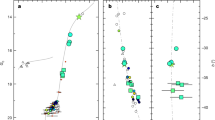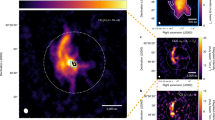Abstract
The stellar stream emerging from the globular cluster Palomar 5 (Pal 5) is one of the few Galactic streams that is clearly associated with its progenitor system. Recent optical photometric data show that Pal 5’s leading arm appears truncated compared with the trailing arm, which is not expected from previous simulations. We demonstrate that inclusion of the rotating Galactic bar in the dynamical modelling of Pal 5 can reproduce the truncation. As the bar sweeps by, stream stars experience differences in net torques near their orbital pericentres. This leads to the formation of discontinuities in the energy distribution of stream members that in turn become apparent as ever-widening gaps in the stream’s spatial density. We conclude that only streams orbiting far from the Galactic Centre or streams on retrograde orbits can be used to unambiguously constrain dark matter subhalo interactions. Additionally, we expect that the Pal 5 leading-arm debris should reappear south of the density truncation.
This is a preview of subscription content, access via your institution
Access options
Access Nature and 54 other Nature Portfolio journals
Get Nature+, our best-value online-access subscription
$29.99 / 30 days
cancel any time
Subscribe to this journal
Receive 12 digital issues and online access to articles
$119.00 per year
only $9.92 per issue
Buy this article
- Purchase on Springer Link
- Instant access to full article PDF
Prices may be subject to local taxes which are calculated during checkout





Similar content being viewed by others
References
Odenkirchen, M. et al. Detection of massive tidal tails around the globular cluster Palomar 5 with Sloan Digital Sky Survey commissioning data. Astrophys. J. Lett. 548, L165–L169 (2001).
York, D. G. et al. The Sloan Digital Sky Survey: technical summary. Astron. J. 120, 1579–1587 (2000).
Odenkirchen, M., Grebel, E. K., Dehnen, W., Rix, H.-W. & Cudworth, K. M. Kinematic study of the disrupting globular cluster Palomar 5 using VLT spectra. Astron. J. 124, 1497–1510 (2002).
Fritz, T. K. & Kallivayalil, N. The proper motion of Palomar 5. Astrophys. J. 811, 123 (2015).
Dotter, A., Sarajedini, A. & Anderson, J. Globular clusters in the outer galactic halo: new Hubble Space Telescope/Advanced Camera for surveys imaging of six globular clusters and the galactic globular cluster age-metallicity relation. Astrophys. J. 738, 74 (2011).
Odenkirchen, M., Grebel, E. K., Kayser, A., Rix, H.-W. & Dehnen, W. Kinematics of the tidal debris of the globular cluster Palomar 5. Astron. J. 137, 3378–3387 (2009).
Kuzma, P. B., Da Costa, G. S., Keller, S. C. & Maunder, E. Palomar 5 and its tidal tails: a search for new members in the tidal stream. Mon. Not. R. Astron. Soc. 446, 3297–3309 (2015).
Küpper, A. H. W. et al. Globular cluster streams as galactic high-precision scales — the poster child Palomar 5. Astrophys. J. 803, 80 (2015).
Bovy, J., Bahmanyar, A., Fritz, T. K. & Kallivayalil, N. The shape of the inner Milky Way halo from observations of the Pal 5 and GD-1 stellar streams. Astrophys. J. 833, 31 (2016).
Ibata, R. A., Lewis, G. F. & Martin, N. F. Feeling the pull: a study of natural galactic accelerometers. I. photometry of the delicate stellar stream of the Palomar 5 globular cluster. Astrophys. J. 819, 1 (2016).
Yoon, J. H., Johnston, K. V. & Hogg, D. W. Clumpy streams from clumpy halos: detecting missing satellites with cold stellar structures. Astrophys. J. 731, 58 (2011).
Carlberg, R. G., Grillmair, C. J. & Hetherington, N. The Pal 5 star stream gaps. Astrophys. J. 760, 75 (2012).
Erkal, D., Koposov, S. E. & Belokurov, V. A sharper view of Pal 5’s tails: discovery of stream perturbations with a novel non-parametric technique. Mon. Not. R. Astron. Soc. 470, 60–85 (2017).
Bovy, J., Erkal, D. & Sanders, J. L. Linear perturbation theory for tidal streams and the small-scale CDM power spectrum. Mon. Not. R. Astron. Soc. 466, 628–668 (2017).
Thomas, G. F., Ibata, R., Famaey, B., Martin, N. F. & Lewis, G. F. Exploring the reality of density substructures in the Palomar 5 stellar stream. Mon. Not. R. Astron. Soc. 460, 2711–2719 (2016).
Dehnen, W., Odenkirchen, M., Grebel, E. K. & Rix, H.-W. Modeling the disruption of the globular cluster Palomar 5 by galactic tides. Astron. J. 127, 2753–2770 (2004).
Pearson, S., Küpper, A. H. W., Johnston, K. V. & Price-Whelan, A. M. Tidal stream morphology as an indicator of dark matter halo geometry: the case of Palomar 5. Astrophys. J. 799, 28 (2015).
Chambers, K. C. et al. The Pan-STARRS1 surveys. Preprint at https://arxiv.org/abs/1612.05560 (2016).
Bernard, E. J. et al. A synoptic map of halo substructures from the Pan-STARRS1 3π survey. Mon. Not. R. Astron. Soc. 463, 1759–1768 (2016).
Hattori, K., Erkal, D. & Sanders, J. L. Shepherding tidal debris with the Galactic bar: the Ophiuchus stream. Mon. Not. R. Astron. Soc. 460, 497–512 (2016).
Price-Whelan, A. M., Sesar, B., Johnston, K. V. & Rix, H.-W. Spending too much time at the Galactic bar: chaotic fanning of the Ophiuchus stream. Astrophys. J. 824, 104 (2016).
Wegg, C. & Gerhard, O. Mapping the three-dimensional density of the Galactic bulge with VVV red clump stars. Mon. Not. R. Astron. Soc. 435, 1874–1887 (2013).
Gerhard, O. Pattern speeds in the Milky Way. Memorie della Societa Astronomica Italiana Supplementi 18, 185–188 (2011).
Balbinot, E. & Gieles, M. The devil is in the tails: the role of globular cluster mass evolution on stream properties. Preprint at https://arxiv.org/abs/1702.02543 (2017).
Englmaier, P. & Gerhard, O. Gas dynamics and large-scale morphology of the Milky Way galaxy. Mon. Not. R. Astron. Soc. 304, 512–534 (1999).
Dehnen, W. The effect of the outer Lindblad resonance of the Galactic bar on the local stellar velocity distribution. Astron. J. 119, 800–812 (2000).
Gaia Collaboration. et al. The Gaia mission. Astron. Astrophys. 595, A1 (2016).
Johnston, K. V. A prescription for building the Milky Way’s halo from disrupted satellites. Astrophys. J. 495, 297–308 (1998).
Helmi, A. & White, S. D. M. Building up the stellar halo of the Galaxy. Mon. Not. R. Astron. Soc. 307, 495–517 (1999).
Johnston, K. V., Sackett, P. D. & Bullock, J. S. Interpreting debris from satellite disruption in external galaxies. Astrophys. J. 557, 137–149 (2001).
Binney, J. & Tremaine, S. Galactic Dynamics 2nd edn (Princeton Univ. Press, 2008).
Hendel, D. & Johnston, K. V. Tidal debris morphology and the orbits of satellite galaxies. Mon. Not. R. Astron. Soc. 454, 2472–2485 (2015).
Erkal, D., Belokurov, V., Bovy, J. & Sanders, J. L. The number and size of subhalo-induced gaps in stellar streams. Mon. Not. R. Astron. Soc. 463, 102–119 (2016).
Diemand, J. et al. Clumps and streams in the local dark matter distribution. Nature 454, 735–738 (2008).
Klypin, A., Kravtsov, A. V., Valenzuela, O. & Prada, F. Where are the missing Galactic satellites? Astrophys. J. 522, 82–92 (1999).
Hui, L., Ostriker, J. P., Tremaine, S. & Witten, E. On the hypothesis that cosmological dark matter is composed of ultra-light bosons. Phys. Rev. Lett. 95, 043541 (2017).
D’Onghia, E., Springel, V., Hernquist, L. & Keres, D. Substructure depletion in the Milky Way halo by the disk. Astrophys. J. 709, 1138–1147 (2010).
Garrison-Kimmel, S. et al. Not so lumpy after all: modeling the depletion of dark matter subhalos by Milky Way-like galaxies. Preprint at https://arxiv.org/abs/1701.03792 (2017).
Errani, R., Peñarrubia, J., Laporte, C. F. P. & Gómez, F. A. The effect of a disc on the population of cuspy and cored dark matter substructures in Milky Way-like galaxies. Mon. Not. R. Astron. Soc. 465, L59–L63 (2017).
Amorisco, N. C., Gómez, F. A., Vegetti, S. & White, S. D. M. Gaps in globular cluster streams: giant molecular clouds can cause them too. Mon. Not. R. Astron. Soc. 463, L17–L21 (2016).
Sanders, J. L., Bovy, J. & Erkal, D. Dynamics of stream-subhalo interactions. Mon. Not. R. Astron. Soc. 457, 3817–3835 (2016).
Sandford, E., Küpper, A. H. W., Johnston, K. V. & Diemand, J. Quantifying tidal stream disruption in a simulated Milky Way. Mon. Not. R. Astron. Soc. 470, 522–538 (2017).
Erkal, D. & Belokurov, V. Properties of dark subhaloes from gaps in tidal streams. Mon. Not. R. Astron. Soc. 454, 3542–3558 (2015).
Miyamoto, M. & Nagai, R. Three-dimensional models for the distribution of mass in galaxies. Pub. Astron. Soc. Jpn 27, 533–543 (1975).
Navarro, J. F., Frenk, C. S. & White, S. D. M. The structure of cold dark matter halos. Astrophys. J. 462, 563–575 (1996).
Wang, Y., Zhao, H., Mao, S. & Rich, R. M. A new model for the Milky Way bar. Mon. Not. R. Astron. Soc. 427, 1429–1440 (2012).
Dwek, E. et al. Morphology, near-infrared luminosity, and mass of the Galactic bulge from COBE DIRBE observations. Astrophys. J. 445, 716–730 (1995).
Hernquist, L. & Ostriker, J. P. A self-consistent field method for galactic dynamics. Astrophys. J. 386, 375–397 (1992).
Portail, M., Wegg, C., Gerhard, O. & Martinez-Valpuesta, I. Made-to-measure models of the Galactic box/peanut bulge: stellar and total mass in the bulge region. Mon. Not. R. Astron. Soc. 448, 713–731 (2015).
Bovy, J. galpy: a python library for Galactic dynamics. Astrophys. J. Supp. 216, 29–56 (2015).
Bovy, J. et al. The Milky Way’s circular-velocity curve between 4 and 14 kpc from APOGEE data. Astrophys. J. 759, 131 (2012).
Xue, X. X. et al. The Milky Way’s circular velocity curve to 60 kpc and an estimate of the dark matter halo mass from the kinematics of 2400 SDSS blue horizontal-branch stars. Astrophys. J. 684, 1143–1158 (2008).
Deason, A. J., Belokurov, V., Evans, N. W. & An, J. Broken degeneracies: the rotation curve and velocity anisotropy of the Milky Way halo. Mon. Not. R. Astron. Soc. 424, L44–L48 (2012).
Prince, P. & Dormand, J. High order embedded Runge-Kutta formulae. J. Comput. Appl. Math. 7, 67–75 (1981). http://www.sciencedirect.com/science/article/pii/0771050X81900103
Hairer, E., Nørsett, S. P. & Wanner, G. Solving Ordinary Differential Equations. I. Nonstiff Problems 2nd edn (Springer-Verlag, Berlin, 2000).
Price-Whelan, A., Sipocz, B. & Oh, S. adrn/gala: version 0.1.3 (2017); https://doi.org/10.5281/zenodo.321907.
Astropy Collaboration. et al. Astropy: a community Python package for astronomy. Astron. Astrophys. 558, A33 (2013).
Schönrich, R. Galactic rotation and solar motion from stellar kinematics. Mon. Not. R. Astron. Soc. 427, 274–287 (2012).
Schönrich, R., Binney, J. & Dehnen, W. Local kinematics and the local standard of rest. Mon. Not. R. Astron. Soc. 403, 1829–1833 (2010).
Fardal, M. A., Huang, S. & Weinberg, M. D. Generation of mock tidal streams. Mon. Not. R. Astron. Soc. 452, 301–319 (2015).
Gibbons, S. L. J., Belokurov, V. & Evans, N. W. ‘Skinny Milky Way please’, says Sagittarius. Mon. Not. R. Astron. Soc. 445, 3788–3802 (2014).
Choi, J.-H., Weinberg, M. D. & Katz, N. The dynamics of tidal tails from massive satellites. Mon. Not. R. Astron. Soc. 381, 987–1000 (2007).
Bovy, J. Dynamical modeling of tidal streams. Astrophys. J. 795, 95 (2014).
Acknowledgements
We acknowledge A. Brown, the Gaia Project Scientist Support Team and the Gaia Data Processing and Analysis Consortium (DPAC) for making the PyGaia package open source. We thank the Flatiron Institute Center for Computational Astrophysics for providing the space to carry out this project. S.P. thanks J. Chanamé and E. Bernard for insightful discussions. K.V.J. and S.P. acknowledge support from National Science Foundation grant AST-1614743.
Author information
Authors and Affiliations
Contributions
S.P. led the modelling, analysis, figure production and writing of the paper. A.M.P.-W. assisted with the modelling, writing and with producing figures. All authors discussed the results, their interpretation and the presentation of the paper.
Corresponding author
Ethics declarations
Competing interests
The authors declare no competing financial interests.
Additional information
Publisher’s note: Springer Nature remains neutral with regard to jurisdictional claims in published maps and institutional affiliations.
Rights and permissions
About this article
Cite this article
Pearson, S., Price-Whelan, A.M. & Johnston, K.V. Gaps and length asymmetry in the stellar stream Palomar 5 as effects of Galactic bar rotation. Nat Astron 1, 633–639 (2017). https://doi.org/10.1038/s41550-017-0220-3
Received:
Accepted:
Published:
Issue Date:
DOI: https://doi.org/10.1038/s41550-017-0220-3
This article is cited by
-
The tidal remnant of an unusually metal-poor globular cluster
Nature (2020)
-
Mind the Galactic bar
Nature Astronomy (2017)



